
A Brand New Novel
Josephine Baker, the early-20th-century African-American dancer, comic, and singer–hugely famous in Paris. Did you know that she was also a spy for the French Resistance during WWII?
Art and artifacts Marguerite, Elèonore, Sanchia, and Beatrice, the Sisters of Savoy in FOUR SISTERS, ALL QUEENS, might have seen in their lifetimes in France, England, Germany, Italy.

King Louis IX Carrying the Crown of Thorns Date: ca. 1245-48
As described in FOUR SISTERS, ALL QUEENS, this stained glass depicts French King Louis IX (Saint Louis) carrying the Holy Crown of Thorns after buying them for the kingdom from Baldwin, the Emperor of Constantinople. Here the crown is shown in a golden chalice, but chroniclers wrote of his bearing it in a golden box, barefoot, all the way from Sens to Paris — a walk that would have taken him more than a week to complete.
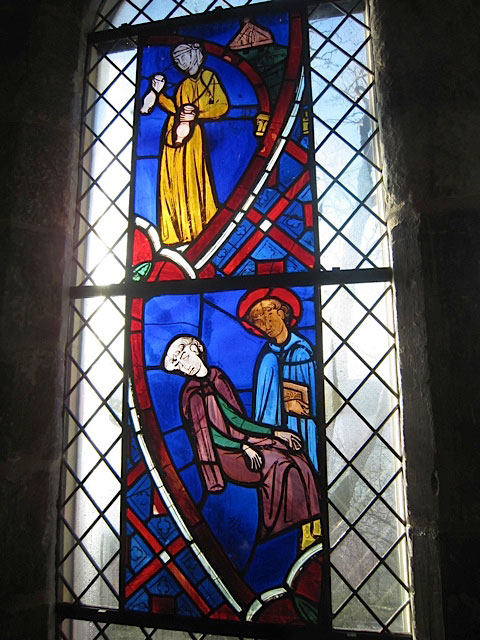
Two Scenes from the Legend of Saint-Germain de Paris, from the former Lady Chapel of the Benedictine Abbey of Saint-Germain-des-Près
Demolished in 1802, the Lady Chapel at Saint-Germain-des-Près was aglaze with beautiful stained glass. The seven windows in the apse depicted scenes from the legends of the Virgin Mary, Saint Vincent of Saragossa, and Saint Germain of Paris. These two panels, dating to 1247-1250, depict scenes from the legend of Germain. In the upper panel, a female servant carries two flasks of wine, one of which is poisoned. According to the legend, she served the wine to Germain and his companion, who drank the poisoned wine and died instantly. In the lower panel, Germain’s apparition reassures a sleeping monk that the saint’s relics will remain unharmed during the imminent Norman invasion.

From Christ Church Cathedral at Cantebury, Kent, England, 1175-80.
This Unusual scene depicts St. Lawrence not stretched out on a grill, but in flames at his feet and head. St. Augustine and St. Ambrose contended that Lawrence overcame the extenal fire by the power of three fires within: the ardor of faith, the love of Christ, and the true knowledge of God.
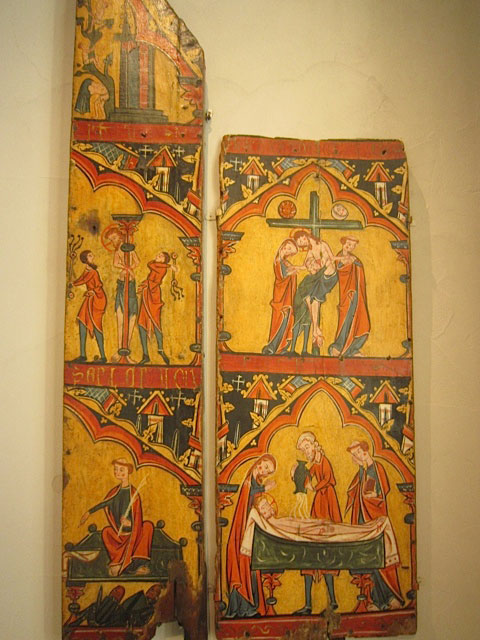
Scenes from the life of Christ: Disrobing Youths from the Entry into Jerusalem, Flagellation, and Angel at the Sepulchre; Descent from the Cross, Preparation of Christ’s Body for His Entombment; Arrest of Christ, Christ in Limbo
Spanish Painter (13th century)
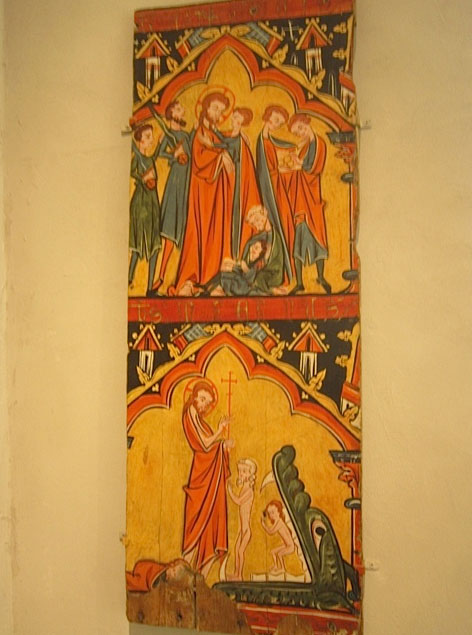
Arrest of Christ – Christ in Limbo
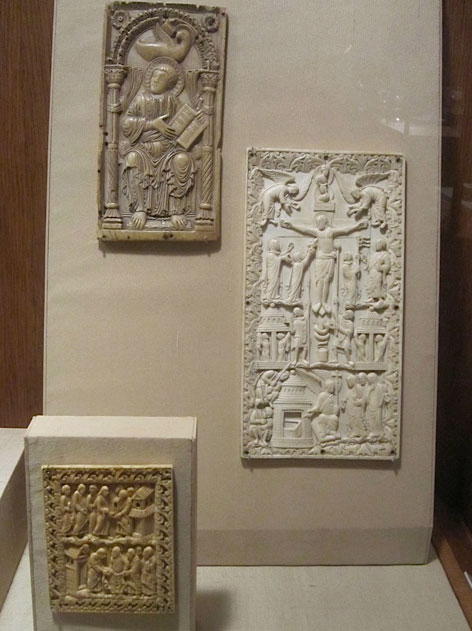
Plaque with Saint John the Evangelist (upper left), Aachen, Germany, early 9th century. Ivory.
Might Sanchia of Provence seen this beautiful plaque from the time of Charlemagne in the cathedral at Aachen where she was crowned Queen of Germany? I only wish I had zoomed in for a closer view of St. John, a young man here whose robes fold and drape exquisitely. In one hand he holds a book bearing the opening words from his Gospel: IN PRINCI/PIO ERAT/VERBATIM (“In the beginning was the Word”). The upper border bears a line from the fifth-century Roman poet Sedulius: MORE VOLANS AQVILE VERBVM PETIT ASTRA IOHANNIS (Flying like an eagle the word of John aspires to heaven). This plaque may have served as an ecclesiatical book cover, possibly of the Gospel of John.
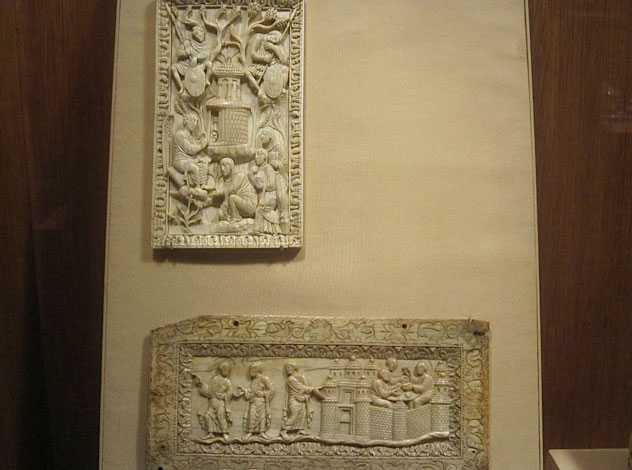
Three Women at the Holy Sepulcher (upper), north Italy, early 10th century; Plaque with Scenes at Emmaus (lower), Metz, Lorraine (Moselle), France, 850-900. Elephant ivory
On a plaque probably used to decorate a book, the Holy Women approach the tomb of Jesus with their jars of ointment and are informed by a winged angel outside the open tomb that Christ has risen. The soldiers supposedly guarding the tomb appear unconscious, as per Matthew 28:4, which states that they were “struck with terror, and became as dead men.”
The lower plaque, carved during or soon after the reign of the emperor Charlemagne’s son Charles the Bald, depicts lively figures using broad gestures to tell the story. On the left, the resurrected Christ appears to two of his disciples on the road to Emmaus. On the right, Christ reveals his identity to them in a supper at Emmaus, represented by city walls and an
elaborate gate. This plaque probably formed the front or back of a box.

Plaque with Censing Angels, Haute-Vienne, Limousin, France, 1170-80. Champleve enamel and copper gilt
Two mournful angels are showing waving censers over what would have been the scene of Christ’s crucifixion. All around them, stylized clouds; behind them; copper gilt in a swirling pattern known as vermicule, in a plaque that must have decorated one of the largest crosses produced at Limoges — at least four feet high.
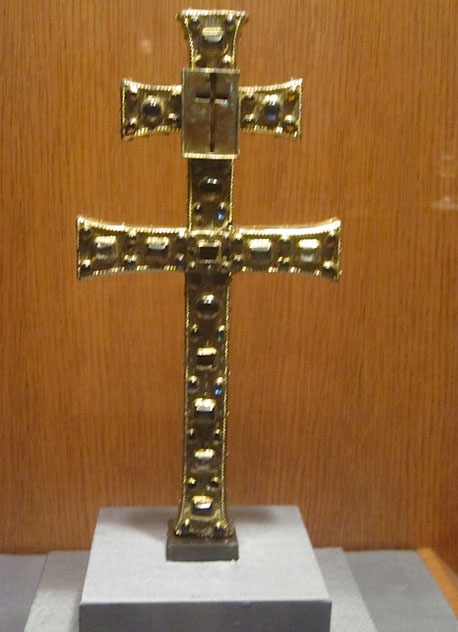
Reliquary Cross, Haute-Vienne, Limousin, France, 1180. Silver gilt, crystal, and glass cabochons; wood core.
More than 60 glass cabochons adorn this cross on both sides, as well as twisted wire, beading, repousse florets, and engraved concentric circles. The relics, behind the plaque on the front which bears a cross, are identified by engravings on the sides: a piece of the True Cross, said to be discovered by the empress Helena of Constantinople — mother of Constantine the Great — in the 4th century, thought to be the actual cross on which
Christ was crucified. King Louis IX obtains a piece of the True Cross in FOUR SISTERS, ALL QUEENS; he built the magnificent Sainte-Chappelle in Paris to house the holy relics.

Cross, Suffolk, England, 1150-60, possibly from the abbey at Bury St. Edmunds. Walrus ivory with traces of paint.
This cross is said to be one of the great medieval finds of the 20th century and a masterpiece in ivory carving, featuring more than 100 figures depicting scenes from the Old and New Testaments.
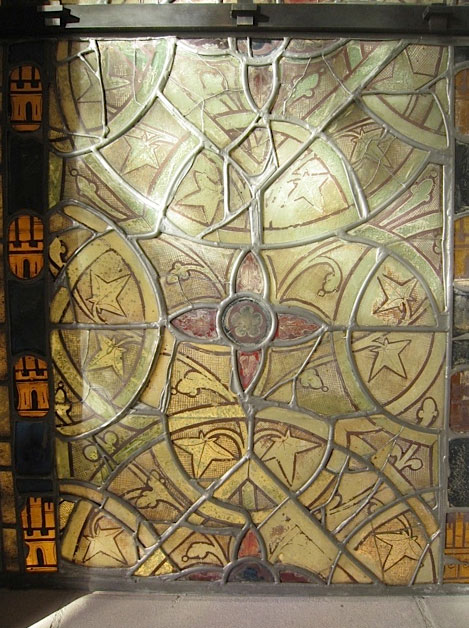
Grisaille made in Rouen, Normandy, 1260-1270
This panel is part of a set of eight from a window in one of three chapels at the Norman residence of the French monarchs. It represents a mid-century transitional stage in royal French ateliers. The conventionalized acanthus buds are a continuation of earlier tastes, while the ivy leaves, delineated with hair-thin veins, reflect the newer, naturalizing tendencies. The castles in the border are devices of the kingdom of Castile and indicate royal patronage, probably that of Louis IX (1226-1272), who claimed the right to the Spanish throne through his mother, Blanche of Castile.

Cauldron
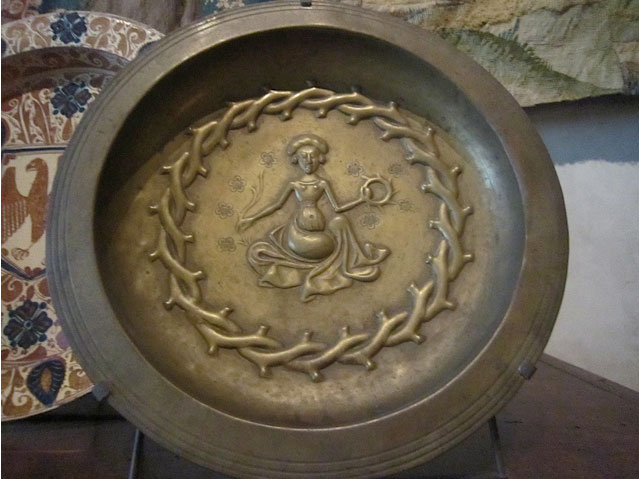
Crown of Thorns Platter
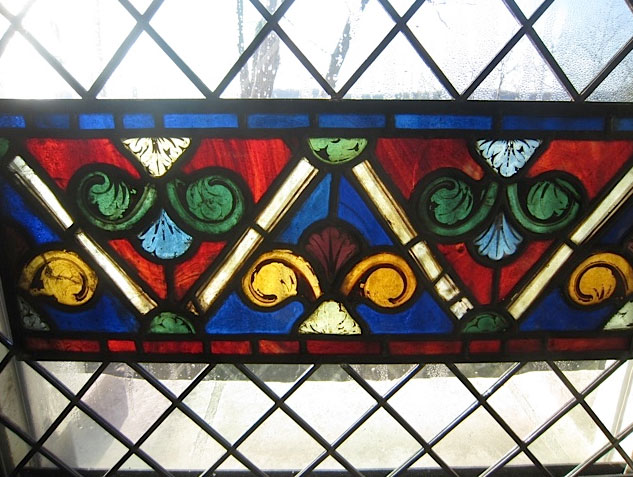
Stained Glass

Stained Glass
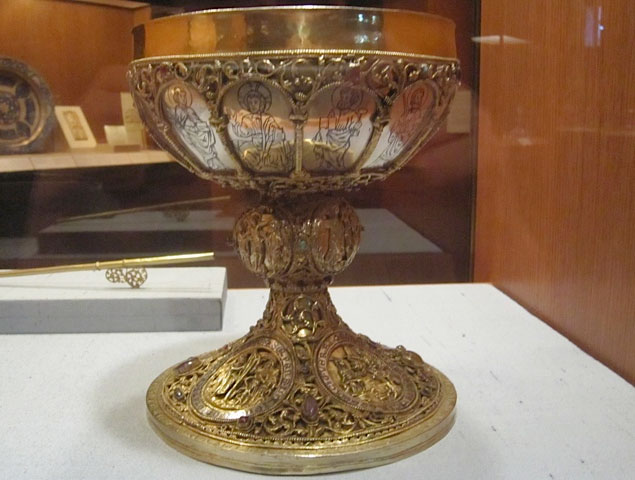
Chalice, Germany, 1230-50. Silver gilt, niello, and jewels
Stunning! The craftsmanship is amazing considering the era. This chalice was used to celebrate the Eucharist, commemorating his sacrifice by eating bread and drinking wine said to be transformed into his flesh and blood during the ceremony. On the base are four Old Testament scenes thought to prefigure New Testament scenes on the knop above: Moses and the Burning Bush (the Annunciation), the flowering of Aaron’s rod (the Nativity), Noah’s Ark (the baptism of Christ), and Moses and the Brazen Serpent (the Crucifixion). The niello decoration on the bowl’s exterior depicts Christ standing with the
twelve apostles.
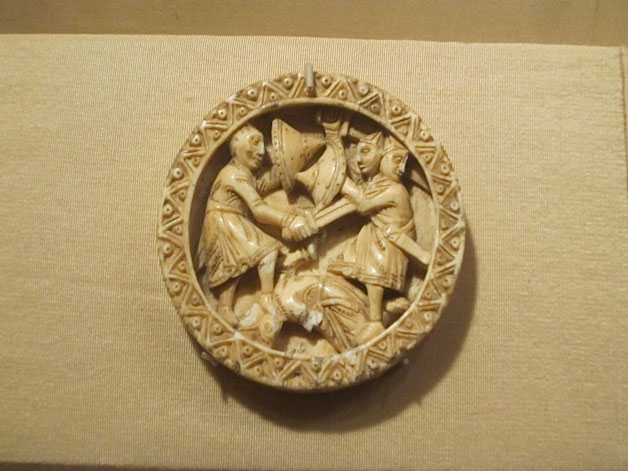
Game piece: Hercules Slaying the Three-Headed Geryon, Cologne, Germany, 1150. Walrus ivory
This game piece, from a backgammon precursor known as “tables,” depicts Hercules slaying the three-headed monster Geryon, shown slain at the bottom of the scene and with Hercules’s foot on its neck. This tableman contains traces of paint; often pieces for one side in the game were painted while those for the opposing side were left unpainted.
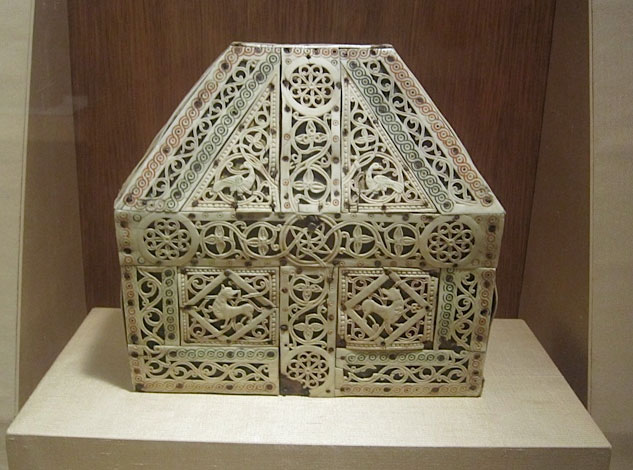
Bursa Reliquary, North Italy, 10th century. Bone, paint, copper gilt, and sycamore
What exquisite carving in this ivory box, with a style and designs reminiscent of large-scale northern Italian stone carving of the era. Its shape resembles a bursa, a pouch in which saints’ relics were carried. Originally, gilded copper foil gleamed from the open spaces in the carving. Beatrice, commanding troops from her post in Rome prior to becoming Queen of Italy (Sicily), might have seen this stunning work of art.
Aquamanilia (aqua=water + manus=hand) were a type of pitcher used for washing the hands.
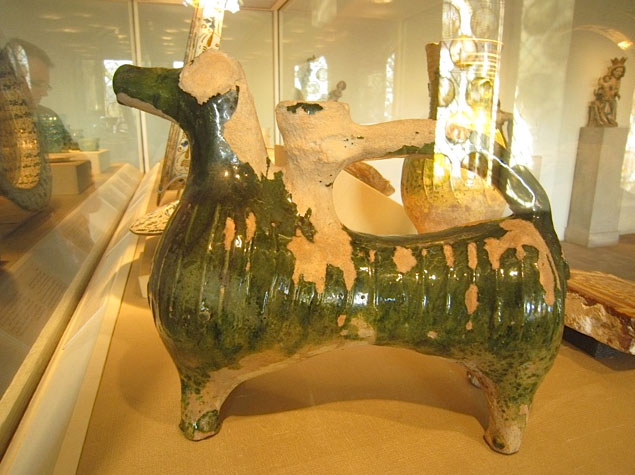
Glazed ceramic aquamanile in the form of a ram, England, 1250–1350
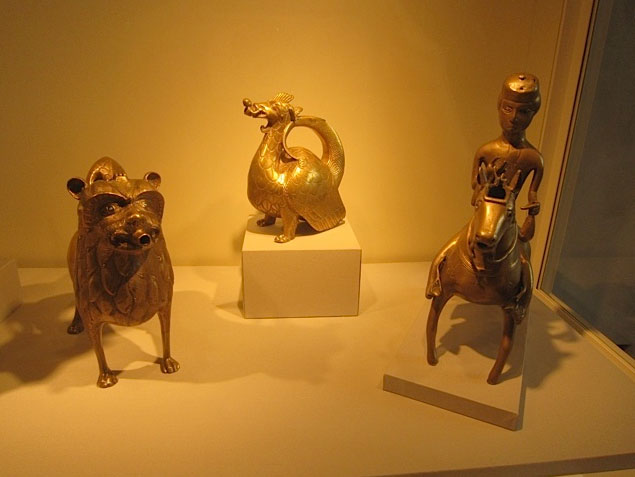
Aquamanilia: in the form of a lion (left), a dragon (center), and a man on horseback, copper alloy, North Germany, 13th century

Rooster Pitcher
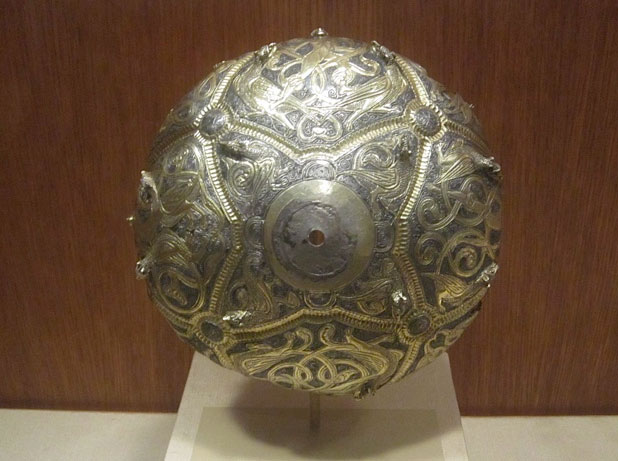
Bowl of a drinking cup, England or Scandinavia, late 12th century, silver, silver guilt, and niello
Engraved with nude men and dragons, this vessel was probably used for secular rather than sacred purposes: for celebratory feasts, perhaps, such as Eleonore’s coronation as Queen of England in FOUR SISTERS, ALL QUEENS, an opulent affair with “lions in cages, dancing girls in exotic costumes, and a cake as big as a house that surely contains something fanciful within.”

Sherry with Pressto Kommunications publisher Bjarke Larsen at the Vild Med Ord Literary Festival in Aarhus, Denmark, March 2009.

Sherry in Stockholm with Earbooks publisher Shadi Bitar and publicist Camilla Silfvenius, September 2009

Sherry celebrates her birthday in Copenhagen, Denmark, with (from left) Bjarke Larsen, publisher at Pressto Kommunications; Yildiz Akdogan, journalist and member of Danish Parliament; Cengiz Kahraman, journalist; and Sadi Tekelioglu, journalist, September 2009.

Signing books in Belgrade, Serbia, September 2009.
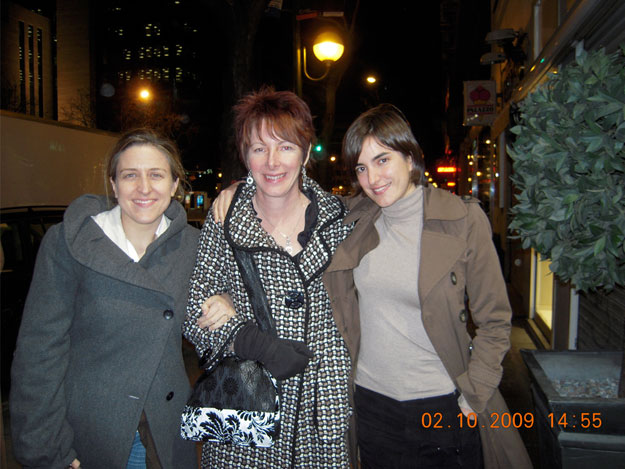
Sherry in Madrid with Ediciones B editor Lucia Luengo, left, and Carmen Romano, right.
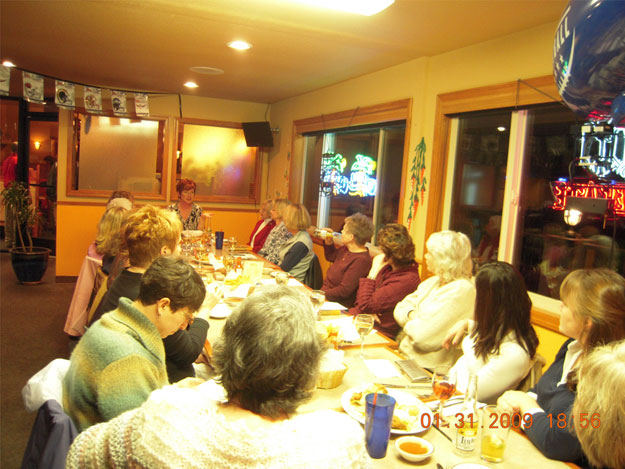
Sherry with members of the Paper House Book Club in St. Marie’s, Idaho, where she returns November 2009 to discuss “The Sword of Medina.”
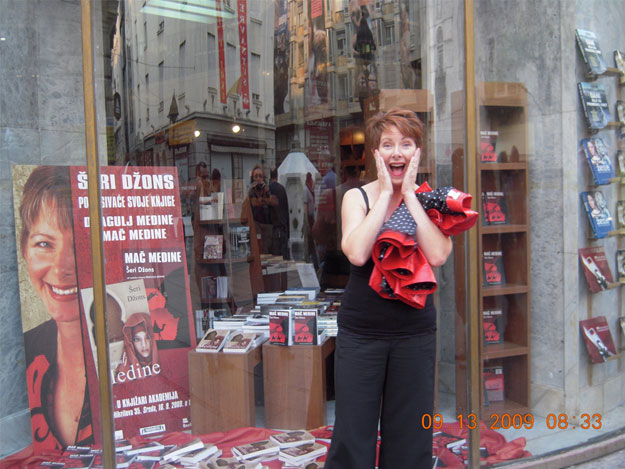
Seri Dzons books fill the window of Academija, Belgrade’s largest bookstore. “The Jewel of Medina” was number 1 in Serbia for four months and was still number 3 when I went there in September. “The Sword of Medina” was number 6.

In Belgrade: Beobook publisher Alexander Jasic, left, and editor Ksenija Graovac